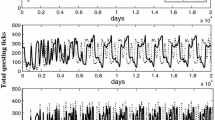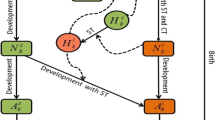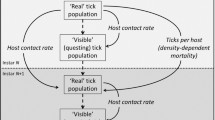Abstract
In this paper, a simple semi-discrete (ticks’ feeding is assumed to occur only during the summers of each year) model for tick population dynamics is presented. Conditions for existence, uniqueness, and stability of a positive equilibrium are found; the system is then studied numerically using parameter estimates calibrated for the tick Ixodes ricinus in Trentino, Italy, and the sensitivity to parameters is examined.
Then, this model is extended to consider a tick-transmitted infection of one species of hosts, while other hosts are incompetent to the infection. Assuming, for simplicity, that the infection is not affecting the total number either of hosts or ticks, a threshold condition for infection persistence is obtained. The dependence of the equilibrium infection prevalence on parameters is studied numerically; in particular, we considered how infection prevalence depends on host densities. This analysis reveals that a ‘dilution effect’ occurs both for competent and for incompetent hosts; this means that, besides a lower threshold for host densities for infection to persist, there exists also an upper threshold: if host densities were higher than the upper threshold, the infection would go to extinction. Numerically, it is found that, for realistic parameter values, the upper threshold is not much higher than observed densities.
Similar content being viewed by others
References
Caraco, T., G. Gardner and B. K. Szymanski (1998). Lyme disease: self regulation and pathogen invasion. J. Theor. Biol. 193, 561–575.
CEA Report (2000). Zecche e malattie trasmesse. La situazione in Trentino. Centro di Ecologia Alpina, Report No. 21, Trento.
Gern, L. and P. F. Humair (2002). Ecology of Borrelia burgdorferi sensu lato in Europe, in Lyme Borreliosis: Biology, Epidemiology and Control, S. Gray, O. Kahl, R. S. Lane and G. Stanek (Eds), CABI-Publishing, pp. 47–90.
Hudson, P. J., A. Rizzoli, B. T. Grenfell, H. Heesterbeek and A. P. Dobson (2002). Ecology of Wildlife Diseases, Oxford University Press.
Humair, P. F., O. Rais and L. Gern (1999). Transmission of Borrelia Ixodes from Apodemus mice and Clethrionomys voles to Ixodes ricinus ticks: differential transmission pattern and overwintering maintenance. Parasitology 118, 38–42.
Jones, L. D., C. R. Davies, G. M. Steele and P. A. Nuttall (1987). A novel mode of arbovirus transmission involving a nonviraemic host. Science 237, 775–777.
LoGiudice, K., R. S. Ostfeld, K. A. Schmidt and F. Keesing (2003). The ecology of infectious diseases: effects of host diversity and community composition on Lyme disease risk. Proc. Natl. Acad. Sci. USA 100, 567–571.
Mwambi, H. G., J. Baumgartner and K. P. Hadeler (2000). Ticks and tick-borne diseases: a vector-host interaction model for the brown ear tick. Stat. Meth. Med. Res. 9, 279–301.
Norman, R., R. G. Bowers, M. Begon and P. J. Hudson (1999). Persistence of tick-borne virus in the presence of multiple host species: tick reservoirs and parasite mediated competition. J. Theor. Biol. 200, 111–118.
O’Callaghan, C. J, G. F. Medley, T. F. Peter and B. D. Perry (1998). Investigating the epidemiology of heartwater by means of a transmission dynamics model. Parasitology 117, 49–61.
Randolph, S. E., R. M. Green, A. N. Hoodless and M. F. Peacey (2002). An empirical quantitative framework for the seasonal population dynamics of the tick Ixodes ricinus. Int. J. Parasitology 32, 979–989.
Randolph, S. E. and D. J. Rogers (1997). A generic population model for the African tick Rhipicephalus appendiculatus. Parasitology 115, 265–279.
Rosà, R., A. Pugliese, R. Norman and P. J. Hudson (2003). Basic reproduction number in models for tick-borne infections including non-viraemic transmission, extended feeding and tick aggregation. J. Theor. Biol. 224, 359–376.
Rosà, R., A. P. Rizzoli, A. Pugliese and P. J. Hudson (2004). The role of host biodiversity, density and transmission routes in generating non-linearities in tick borne infections (submitted).
Sandberg, S. and T. E. Awerbuch (1992). A comprehensive multiple matrix model representing the life cycle of the tick that transmits the agent of Lyme disease. J. Theor. Biol. 157, 203–220.
Sonenshine, D. E. (1991). Biology of Ticks, Vol. 1, Oxford University Press.
Author information
Authors and Affiliations
Corresponding author
Rights and permissions
About this article
Cite this article
Ghosh, M., Pugliese, A. Seasonal population dynamics of ticks, and its influence on infection transmission: A semi-discrete approach. Bull. Math. Biol. 66, 1659–1684 (2004). https://doi.org/10.1016/j.bulm.2004.03.007
Received:
Accepted:
Issue Date:
DOI: https://doi.org/10.1016/j.bulm.2004.03.007




